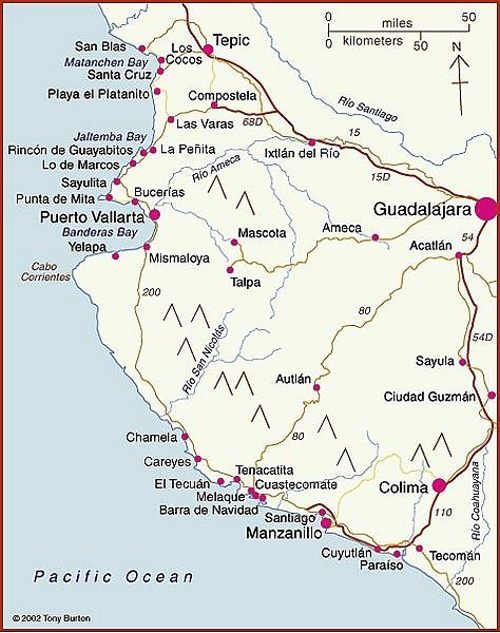The map shows the coasts of the states of Colima, Jalisco and Nayarit. These states all have some great beaches, and tourism is an important activity in many of the towns shown on the map. Some of the beaches are so exposed that the Pacific Ocean waves arriving to smash into the sand offer outstanding surfing opportunities. Other beaches are more sheltered, with calmer waters perfect for swimming.
Besides being important for tourism, Manzanillo is one of Mexico’s largest ports. One of the major reasons why the port of Manzanillo has attracted so much investment in recent decades is that it is easy to access via the major divided highway to/from Guadalajara and the interior of Mexico (and indeed, the US border).
Further north, San Blas was once an important port, but declined as silting blocked the shallow access routes. We described the historical geography of San Blas in a previous post:
Barra de Navidad also had great historical importance, as one of the shipbuilding ports where the Spanish built the ships which traversed the Pacific Ocean to the islands of the Philippines.
The coast around the headland of Punta de Mita used to be the site of rustic fishing villages, from where fisherman also took occasional groups of tourists out to sea whale-watching. This headland, and these villages became one of the best recent examples in Mexico of a forced migration:
In recent years tourism developments have caused more forced relocations than dam construction. One example is the Punta de Mita peninsula, 50 km (30 mi) north of Puerto Vallarta, developed in the 1990s. The existing residents, mostly fishermen, were forced from their homes on the coast so that their ejido lands could be converted into a luxury tourist resort and Jack Nicklaus-designed golf course.
The fishermen were moved from their breezy and somewhat ramshackle palapa huts, interspersed with palm trees, into ugly, concrete block houses a short distance inland, in the purpose-built small town of Emiliano Zapata, which adjoins a redeveloped coastal commercial/ restaurant strip called Anclote. Attempts by the developers to build the fishermen a small boat-building workshop and breakwater to protect the beach caused sand to be eroded from one of the only two remaining beaches with public access. During the resort’s construction an influx of workers from other parts of Mexico pushed prices up and led to social problems. (Geo-Mexico: the geography and dynamics of modern Mexico page 191)
More dramatic changes are now underway along part of this coastline. The area north of Sayulita (which has become a favored wintering location for Americans and Canadians) as far as the beach resort of Rincón de Guayabitos (favored by Mexican families) is slowly being transformed into Mexico’s latest purpose-built tourist resort, in the same way that other Mexican mega-resorts such as Cancún, Huatulco and Ixtapa were created.
Only time will tell what eventually happens to the areas that currently remain as genuine wilderness coast. One thing is sure – the more we develop this coastline, the more ecological damage will be done in the name of progress. Ecologically productive mangroves have been stripped out almost all along the coast, giving way to luxury hotels and marinas. Mangroves are now protected by federal law, but enforcement of this law may not be very effective.
Equally, fewer safe places now remain for the various endangered species of marine turtles who first visited these beaches a very long time before even the early Spanish mariners. One good sign is that active turtle protection programs exist at several of the beaches in this area. Ecological education is a good thing; ecological action is even better.
For more information about the geography of Mexico, buy your copy of Geo-Mexico: the geography and dynamics of modern Mexico today!
3 Responses to “Map of the beaches of Colima, Jalisco and Nayarit, Mexico”
Sorry, the comment form is closed at this time.

Really good information. I’m looking for information about Riviera Nayarit Hotels, since I’m planning on visiting the mexican beaches. And this information really helped me a lot! I need to find good deals, and I’m off to a great vacation!
Chacala Beach is left off the radar? Best cleanest safest swimming beach on the coast!
Surely you don’t want everyone to go there and spoil it for us, do you?
Your comment is appreciated; look for an updated map before too long to reflect the one included in “Western Mexico: A Traveler’s Treasury” my book about the area…